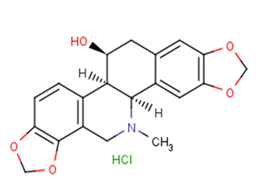
Chelidonine hydrochloride
CAS No. 4312-31-6
Chelidonine hydrochloride( —— )
Catalog No. M20679 CAS No. 4312-31-6
Chelidonine hydrochloride is one of the alkaloids of Chelidonium majus which has broad pharmacological activities.
Purity : >98% (HPLC)
 COA
COA
 Datasheet
Datasheet
 HNMR
HNMR
 HPLC
HPLC
 MSDS
MSDS
 Handing Instructions
Handing Instructions
| Size | Price / USD | Stock | Quantity |
| 5MG | 165 | Get Quote |


|
| 10MG | 243 | Get Quote |


|
| 25MG | 408 | Get Quote |


|
| 50MG | 601 | Get Quote |


|
| 100MG | Get Quote | Get Quote |


|
| 200MG | Get Quote | Get Quote |


|
| 500MG | Get Quote | Get Quote |


|
| 1G | Get Quote | Get Quote |


|
Biological Information
-
Product NameChelidonine hydrochloride
-
NoteResearch use only, not for human use.
-
Brief DescriptionChelidonine hydrochloride is one of the alkaloids of Chelidonium majus which has broad pharmacological activities.
-
DescriptionChelidonine hydrochloride is one of the alkaloids of Chelidonium majus which has broad pharmacological activities.
-
In Vitro——
-
In Vivo——
-
Synonyms——
-
PathwayOthers
-
TargetOther Targets
-
RecptorOthers
-
Research Area——
-
Indication——
Chemical Information
-
CAS Number4312-31-6
-
Formula Weight353.37
-
Molecular FormulaC20H19NO5
-
Purity>98% (HPLC)
-
Solubility——
-
SMILESCl.[H][C@]12[C@@H](O)Cc3cc4OCOc4cc3[C@@]1([H])N(C)Cc1c3OCOc3ccc21
-
Chemical Name——
Shipping & Storage Information
-
Storage(-20℃)
-
ShippingWith Ice Pack
-
Stability≥ 2 years
Reference
1.Wang L Xiaojie H Zhuwen Y et al. Chelidonine suppresses LPS-Induced production of inflammatory mediators through the inhibitory of the TLR4/NF-κB signaling pathway in RAW264.7 macrophages[J]. Biomedicine & Pharmacotherapy 2018 107:1151-1159.
molnova catalog



related products
-
Benzyl-α-GalNAc
Benzyl-α-GalNAc is a potent inhibitor of O-glycosylation and is used to reduce mucin on cell surfaces.
-
C-Peptide, dog
C-Peptide, dog is a component of proinsulin, released from pancreatic beta cells into blood together with insulin. The C-peptide of proinsulin is important for the biosynthesis of insulin but has for a long time been considered to be biologically inert.
-
Lugrandoside
Lugrandoside is a novel phenylpropanoid glycoside, lugrandoside, has been isolated from the caulinary leaves of Digitalis Lutea L. and Difitalis Grandiflora Miller.



 Cart
Cart
 sales@molnova.com
sales@molnova.com


